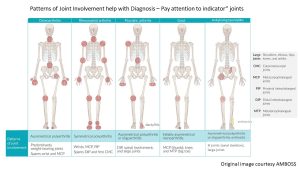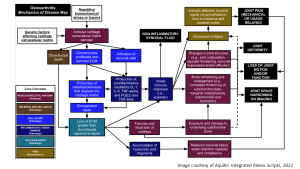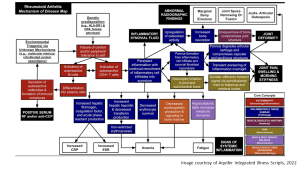6 Check Your Knowledge
While it’s important to learn about each of these joint diseases independently to start, the challenge clinically is to be able to differentiate between the various etiologies in order to best tailor treatment strategies for each patient. Below are a series of tables and exercises to help you compare and contrast some of the distinguishing characteristics of each disease. We will practice these skill in class in the Chronic Joint Disease small group session.
Indicator Joints:
Below is an image showing a series of different ‘homunculi’ or skeletons used in charting to visually record joints affected in a given patient. For each of the diseases below, the homunculus indicates the patterns of joints that tend to be affected in that disease. Not every patients will get all of these affected joints and there can be some overlap or individual patients that don’t ‘follow the rules’ but paying attention to key joints like Distal interphalangeal joints (DIP) which are commonly affected in OA and Psoriatic arthritis but very rare in RA or other spondyloarthropathies, for example, can help you key in on the most likely diagnosis.

Distinguishing between inflammatory arthritis and mechanical arthritis is often the most common initial tasks faced in primary care. STEP 1 also loves to quiz on the differences between osteoarthritis (most common mechanical joint disease in older patients) and rheumatoid arthritis (most common autoimmune joint disease). Below is a table comparing specific differences between radiographic findings in the hands. Many of the findings (ie different patterns of joint space narrowing) are seen in joints outside the hands as well.
OA versus RA Comparison of Radiographic Findings in the Hands
| Osteoarthritis | Rheumatoid Arthritis |
|---|---|
| Marginal osteophytes | Marginal erosions |
| Subchondral sclerosis | Subchondral and periarticular osteopenia |
| foal joint space narrowing | Uniform (concentric) joint space narrowing |
| subchondral cysts | bony resorption |
| DIP's and PIPs | PIP's and MCP's |
| carpometacarpal (CMC) joint, Squaring | Ulnar deviation of fingers |
Chronic Joint Diseases – Concept Mapping!
For those of you who enjoy concept mapping, below are 2 maps of OA versus RA that can help you to link the presenting signs and symptoms of each disease to the underlying pathophysiology. These were created by the Aquifer Clinical Learning Network, you can also link through their website and use partially filled out versions to work through on your own. (Feature coming to this Pressbook soon as the author learns how to do that!!)
Osteoarthritis Integrated Illness Script:

Rheumatoid Arthritis Integrated Illness Script:

